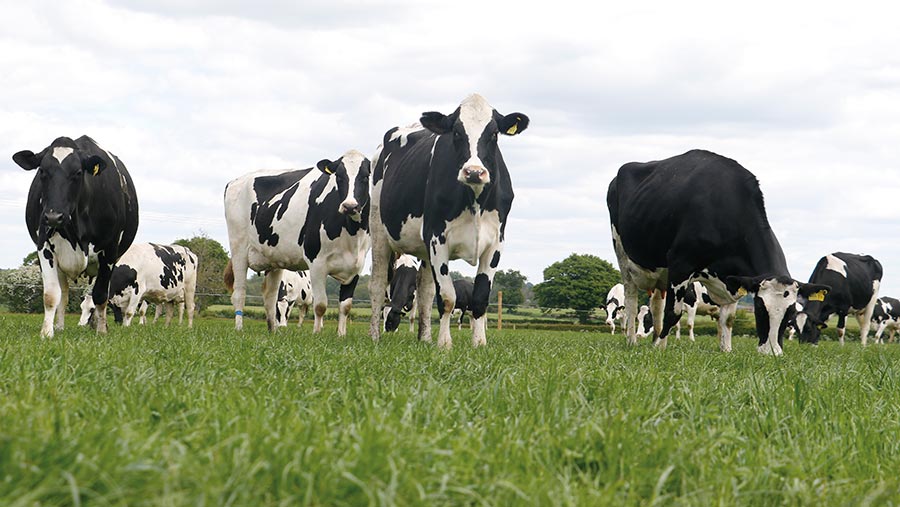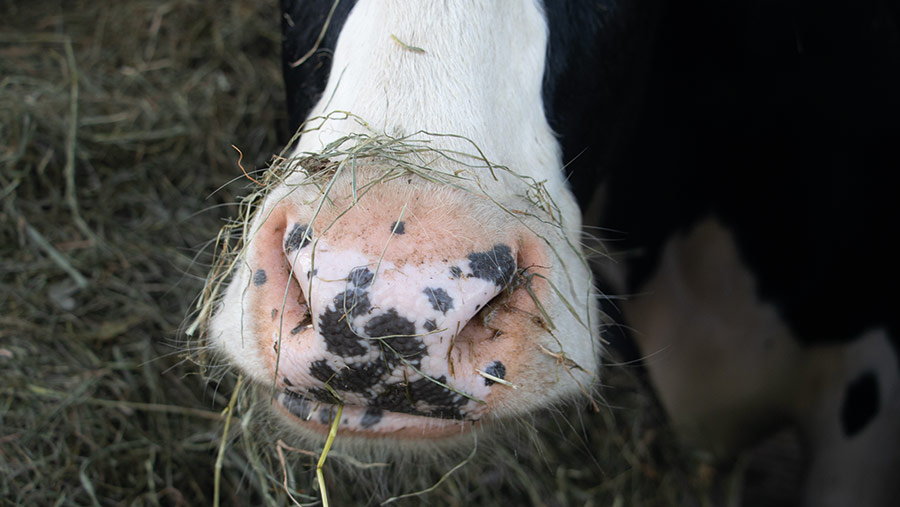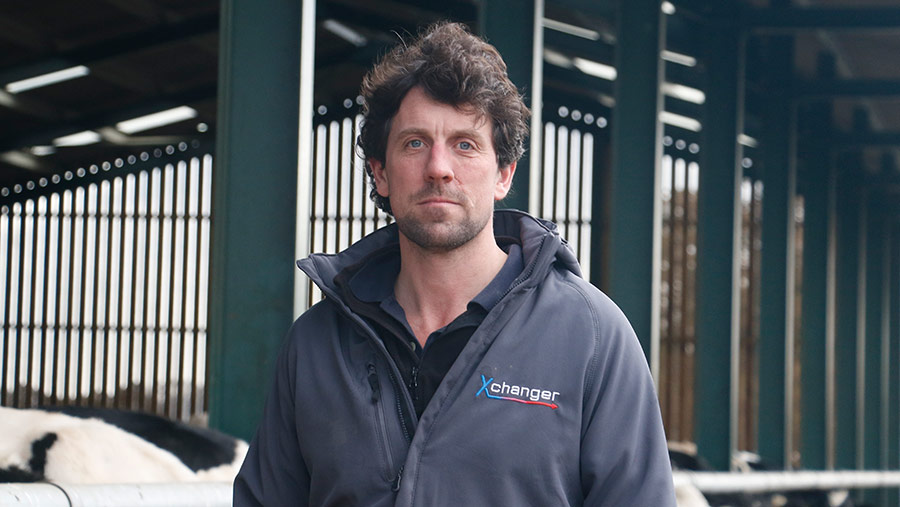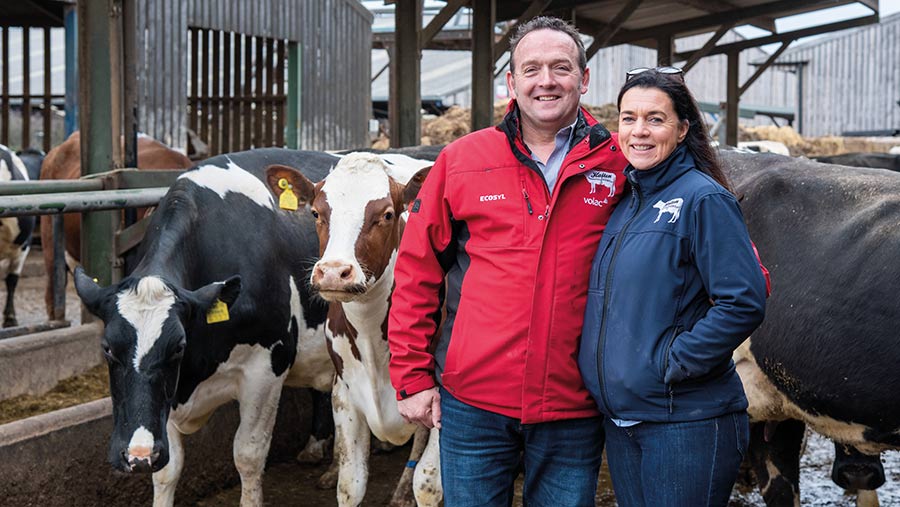Why milk from forage may not be the best KPI for dairy herds
 © Rhian Price
© Rhian Price Milk from forage is a rudimentary figure that should only be used to measure individual progress when herd size is static.
This is according to independent nutritionist Mark Price of Dairy Diagnosis, who believes margin over purchased feed and total purchased feed costs are better measures of cashflow.
See also: How to improve milking efficiency and cow welfare
Pitfalls of milk from forage
Milk from forage is a crude measure because it is assumed the improvement in milk yield comes from forage. However, it could be the result of various factors, explains Mr Price.
For instance, improvements in fertility lower the herd’s average days in milk and increase milk sales.
On top of this, it is often difficult to know what feeds should be classed as forage. For example, brewers’ grains are a direct replacement for forage, but they are not typically considered as forage in rations.
Top cashflow indicators
Two KPIs that can give a better picture of cashflow are:
- Total purchased feed costs on a p/litre basis – this shows how well the business can cope with lower milk prices.
Target: 13p/litre for year-round herds and 8p/litre or lower for block-calvers. Range this year due to higher feed prices – up to 20p/litre. - Margin over purchased feed – this takes into consideration the margin left after deducting monthly feed costs from monthly milk sales. However, use it wisely – if feed prices fall and milk prices rise, margin over purchased feed will look better, but this will not be down to improved performance.
Target: 20-22p/litre.
Source: Mark Price
Return on investment
Depending on your situation, it might not be advantageous to improve milk from forage either, explains Mr Price.
“In a growing business, milk from forage does go out the window. For these farmers, it is far easier to buy more concentrate and milk more cows; this would often generate more profit, but their milk from forage would decrease.”
Forage availability and cost are also key considerations.
“If you want to improve milk from forage, you are almost certainly going to increase forage intakes, and that requires more forage. In densely populated dairy areas, it isn’t always possible or cost-effective,” he warns.
For example, if maize costs £250/t of dry matter (DM) to purchase, and wheat costs £247/t DM, wheat is favourable.
Margin over purchased feed: Example
Margin over purchased feed is largely dependent on milk price.
For example, if two farms are feeding 10kg of blend at £300/t, 6kg dry matter (DM) of grass silage at £135/t DM, 6kg DM of maize at £150/t DM and 3kg of cake at £350/t, the total daily cost amounts to £5.76 a head a day.

© Rhian Price
If cows are averaging 32 litres, total feed costs amount to 18p/litre (£5.76÷32), and purchased feed costs amount to 12.66p/litre (£4.05÷32)
If Farm A is getting 41p/litre of milk on an aligned contract, and farm B, selling direct to a processor, is getting 21.34p/litre, farm A’s margin over purchased feed will be much higher, at 28.34p/litre, in comparison with farm B, at 8.68p/litre.
Workings on daily feed costs are calculated by dividing the feed cost/t by 1,000 to get a price/kg and then multiplying that cost by how much is being fed daily.
Source: Hefin Richards
When should milk from forage be used?
Independent nutritionist Hefin Richards of Rumenation says milk from forage can be useful as an individual barometer to see if performance is improving year on year, providing herd size is constant.
However, it should not be viewed in isolation, and it can be dangerous to benchmark against other businesses unless you are comparing like for like, he cautions.
“It is relevant for anyone running a forage-based system. If you are farming 121ha (300 acres) and milking 200 cows on an all-grass system, you would use it because you want to be forage-efficient.
“But if you are running a high stocking rate and you are buying in forage, it can be a little bit meaningless, and you would be better off looking at total feed costs and return.”
Mr Richards cautions margin over purchased feed will be “all over the place” with falling milk prices.
In this instance, tracking purchased feed costs or total feed costs, by valuing forage realistically and looking at how much the diet costs in relation to total milk output, is most appropriate.
“All benchmarks have their weaknesses, and no matter what you use, it is about doing the basics really well,” adds Mr Richards.
A rough guide to how milk from forage is calculated
Calculation: Total amount of concentrates used x 11.5ME÷5.3MJ (energy required to provide one litre of milk) – the total amount of milk produced = milk produced from forage on a herd level.
To work out milk from forage on an individual cow basis, divide the figure by the number of cows in milk.
Case study: Richard Bowdler, Shropshire/Welsh border
For Richard Bowdler, growing his dairy business has meant driving milk sales to maximise return on capital and dilute fixed costs.
It is this philosophy that has seen the business ditch grazing and run a housed, flying herd to aid expansion. He now has more than 2,000 cows milked across three owned sites.

Richard Bowdler © Rhian Price
Farm facts
- Milks 2,320 cows across three sites
- 324ha (800 acres) owned and 263ha (650 acres) rented
- Muck exported to forage-growing farms
- Flying herd, housed year-round
- Three-times-a-day milking
- Herd yields 11,250 litres at 3.4% protein and 3.85% fat, rolling 12-month average
- Sells milk to Muller Direct
“Grass-based systems are good, but you can’t drive stocking rates high enough, which is why we changed our system,” he explains.
He says with land in his area being so expensive, it is more economical to purchase feed and produce more milk.
“If you buy land for £15,000/acre at 6% interest, you are paying £800/acre in monthly interest alone. So, if you are only selling 20,000 litres/ha of milk, it is marginal.
“If you can complement that with compound feed and produce more milk, your return is better.”
The metric Mr Bowdler uses is total diet costs, including forage at market value, on a p/litre basis. The current target is to keep this at 16p/litre or less.
He says milk from forage does not always correlate well to farm profit. For this reason, he does not even look at it. However, he concedes forage quality is still important.
“We want to grow as much good-quality feed as we can. For every acre of feed we grow, we aim to produce as much milk as possible.”
He rents 113ha (280 acres) of grassland and grows 324ha (800 acres) of maize on contract to supplement home-grown grass silage, in which he is 80% self-sufficient.
Valuing forage
He values forage at what it costs to buy, not to grow, as this includes a true rental value.
“With forage, many people are guilty of not putting down a true rental value – people will note down £100/t of dry matter [DM], but with drought and commodity inflation, that has changed,” he says.
He is paying about £150/t DM for maize and £135/t DM for grass silage.
Milking cows are fed 10.5kg DM of forage, including grass silage, maize and straw, with the remaining 13kg made up of moist feeds such as brewers’ grains or bread.
He has five bespoke blends, with the most appropriate one chosen to balance the forage being fed at the time.
Buying forage means dealing with variability in quality, but he says it is still an efficient way to feed a cow.
“We must rely on variable forage, but we feed all of it. Some people will obsess with milk from forage and throw away the worst-quality silage. That is bad for business, and is not efficient either,” he says.
Case study: Tom and Karen Halton, Congleton, Cheshire
Milk from forage has become an increasingly important benchmark for Cheshire farmers Tom and Karen Halton.
Now that herd size is static, at 500 cows, they want to double milk from forage to 3,000 litres to reduce their exposure to fluctuations in feed costs.
“Input costs are so volatile, whereas forage, especially grass, is the cheapest feed we can grow,” says Mr Halton.

Tom and Karen Halton © AHDB
Farm facts
- Milks 500 ProCross cows
- Self-replacing herd
- 210ha (520) acres tenanted and 16ha (40 acres) rented
- Three-times-a-day milking
- Yields 11,700 litres at 3.9% butterfat and 3.35% protein
- Milk sold to County Milk
With a high stocking density of 5.7 cows a hectare (2.3 cows an acre), they admit milk from forage has been their biggest hurdle, but this is something they want to overcome.
They graze mid- and late-lactation cows in the spring and summer on an 18ha (45-acre) grazing platform, with more outlying land brought in as the season dictates.
They hope to improve grass use by plate-metering grass regularly and turning cows onto optimum covers.
“In the past, we haven’t taken the grass seriously enough and haven’t had the confidence to reduce buffer feed,” admits Mrs Halton.
Herbal leys are being trialled alongside red clover to improve the protein content of forage.
The Haltons practise multicut silage production, taking about four cuts using a forage box, which they believe is more cost-effective than a forage harvester.
Cows are fed grass silage, maize, chopped straw and a home-made blend of rolled barley, sugar beet, protected soya, rape meal and distillers’ grains, fed at 21.1kg DM a head a day.
Benchmarks
Other key benchmarks they look at monthly are feed rate/litre of milk and purchased feed costs/litre.
These are running at 0.32kg/litre and 13p/litre, respectively, but the Haltons believe they can reduce these by growing better-quality grass and using it more effectively.
“Milk production is stable, and we believe we can push the cows to produce more milk from forage.
“The grass is quite a big win if we can get it right,” says Mrs Halton.
